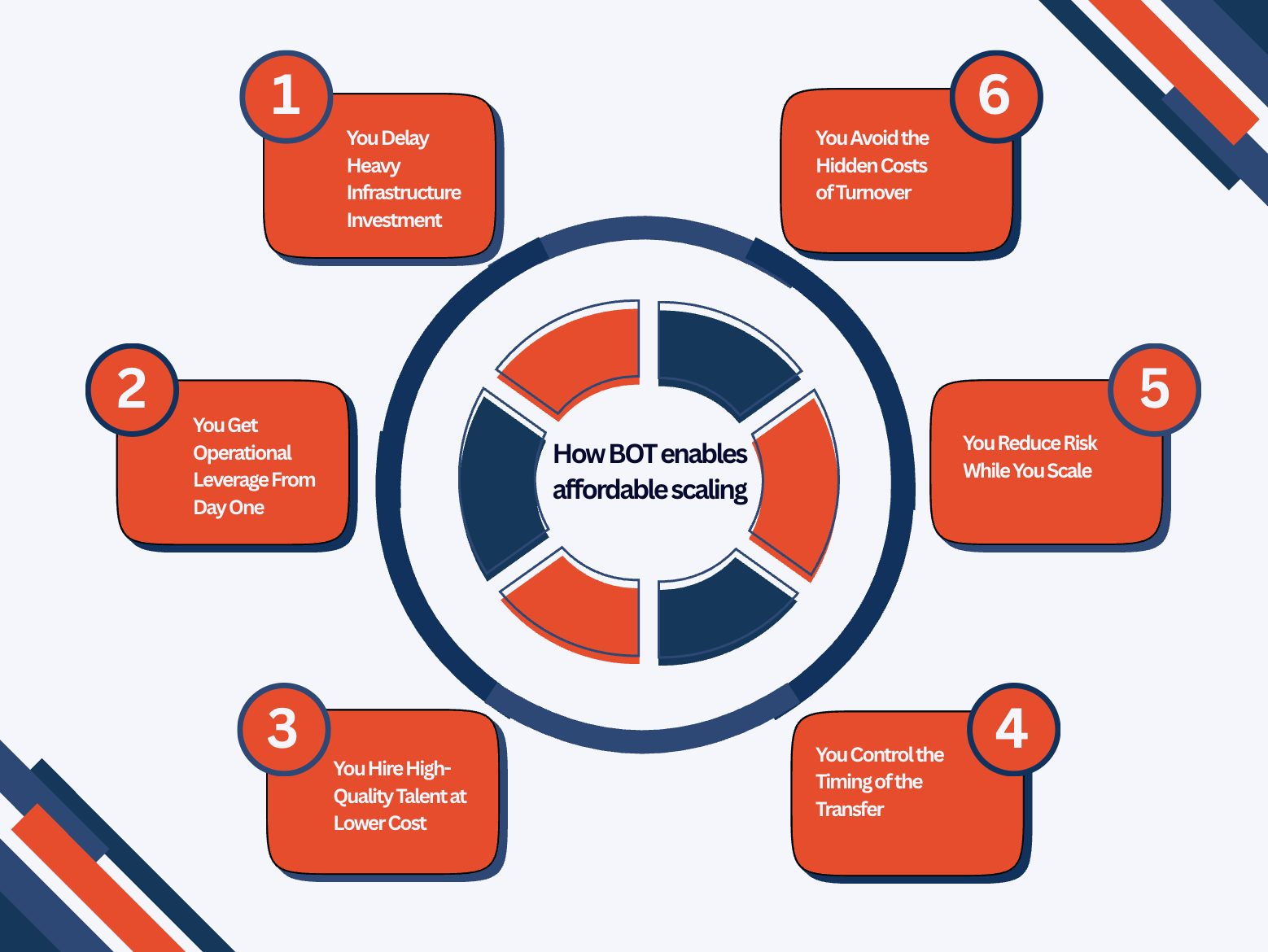Startups need to scale fast, but without burning through their runway. The Build, Operate, Transfer (BOT) model offers an alternative path to traditional outsourcing, giving you the flexibility to build offshore teams that eventually become your own.
This model is gaining traction. According to Grand View Research, the global IT outsourcing market is expected to hit $1.06 trillion by 2030, with more startups adopting BOT as a cost-effective way to expand operations without sacrificing control.
This article breaks down how the BOT model works for startups, what it costs, when to use it, and how to structure it right. It covers the pros and cons, contract must-haves, risk factors, and what scaling looks like after the transfer. If you're wondering whether BOT is affordable enough for your startup, this guide is for you.
How BOT enables affordable scaling

You Delay Heavy Infrastructure Investment.
In the BOT model, the service provider handles the early setup, recruitment, office space, payroll, and operational systems. This means you skip the upfront costs of establishing a legal entity, managing local compliance, or building infrastructure. You’re leveraging someone else's foundation, which significantly reduces capital expenditure during the most cash-sensitive stage of your growth.
You Get Operational Leverage From Day One.
During the “operate” phase, your startup benefits from full access to an already-running operation. Local HR teams, IT support, payroll management, and legal experts are already in place. You get the efficiency of a mature setup without having to build it yourself. It’s an immediate lift, especially if you're entering a new market or scaling quickly after a funding round.
You Hire High-Quality Talent at Lower Cost.
The BOT model lets you scale in talent-rich regions like Latin America, Eastern Europe, or Southeast Asia, where salaries are significantly lower than in the U.S. or Western Europe. According to Accelerance, you can save up to 60% on developer salaries in Latin America while maintaining strong cultural alignment and English proficiency. You get the talent you need without paying Silicon Valley prices.
You Control the Timing of the Transfer.
Unlike traditional outsourcing, BOT gives you full control over when to internalize the team. If you hit your growth milestones faster than expected, you can accelerate the transfer. If the market shifts or funding slows, you can delay it. This flexibility prevents over-hiring or absorbing costs before your startup is ready.
You Reduce Risk While You Scale.
Because the vendor manages operations during the “build” and “operate” phases, your exposure to compliance, staffing, and regulatory risks is limited. You can test a new market or build a new product vertical without long-term commitments. If things don’t go as planned, you’re not burdened with overhead or legal entanglements.
You Avoid the Hidden Costs of Turnover.
With BOT, the team is being built to become yours. There’s a focus on long-term retention, not just project completion. That means better onboarding, higher engagement, and lower attrition. When the team transfers, you're inheriting a stable, product-trained workforce, saving time and money on rehiring or retraining.
How the BOT model works in a startup context
You Start With the “Build” Phase:
This is where the vendor sets up the foundation. They recruit the team, source office space if needed, establish workflows, and ensure compliance with local laws. For startups, this means zero upfront hassle with incorporation, tax registration, or payroll infrastructure in unfamiliar markets.
The vendor acts on your requirements, tech stack, culture fit, seniority, and product roadmap alignment, so the operation reflects your goals from day one. You remain in control of direction and approvals, but execution is handled for you.
The “Operate” Phase Lets You Run Without Owning Yet:
Once the team is built, it enters a managed phase. The vendor handles day-to-day operations, including HR, performance reviews, local benefits, and IT support. You direct the work, set KPIs, and define product or sprint goals.
What’s different from standard outsourcing? The team is integrated into your startup’s workflows. They're not just external contractors, they're being groomed to eventually transition into your company. According to Statista, nearly 35% of global outsourced teams are now long-term partnerships, not just short-term solutions.
The “Transfer” Happens on Your Terms:
At a pre-agreed time, or once specific KPIs are hit, you take full control of the team and infrastructure. Ownership of IP, employee contracts, and local entity registration are handed over. You now manage the operation directly, but with a team already trained in your systems, culture, and codebase.
This stage typically happens within 12 to 36 months, depending on your roadmap, funding cycles, and market validation. The smooth handoff is what separates BOT from outsourcing: you're not losing knowledge or starting from scratch.
You Maintain Strategic Control Throughout:
While the vendor manages logistics, you remain the strategic lead. You decide team structure, toolsets, and tech direction. You set a growth pace and oversee hiring priorities. The BOT model lets you scale operations globally, without giving up control over product or culture.
This hybrid approach gives you startup-level agility with enterprise-grade structure. That’s why BOT is being adopted not only by growth-stage tech companies but increasingly by seed-funded startups looking to expand efficiently.
The Key Challenges Startups Avoid by Leveraging BOT
1. You Avoid High Upfront Setup Costs:
Launching in a new region usually means investing in office space, legal registrations, IT infrastructure, and hiring local experts. With BOT, these expenses are covered by the vendor during the build and operate phases. You don't need to lock capital into facilities or compliance tasks before achieving product-market fit.
According to the World Bank, the average cost of setting up a subsidiary in Latin America can exceed USD 15,000 and take more than 40 days. BOT eliminates that burden and accelerates time to execution.
2. You Skip Legal and Compliance Headaches:
Local labor laws, tax regulations, and data protection policies vary widely across markets. Missteps can lead to fines, lawsuits, or blocked operations. Under a BOT model, the vendor handles these complexities. That means fewer legal risks as you test or enter new markets.
Startups operating globally often face GDPR, HIPAA, or regional employment restrictions. The BOT partner ensures compliance is embedded from day one, helping you avoid regulatory disruption.
3. You Don’t Have To Build HR and Payroll From Scratch:
Hiring and paying international teams involves navigating currency exchange, taxation, labor rules, and benefits standards. Without an established local entity, this is both risky and inefficient.
BOT vendors run fully managed HR and payroll systems during the operate phase. That allows you to focus on team performance, not backend admin. And when the transfer happens, you get a ready-to-go workforce with localized policies already in place.
4. You Minimize Talent Acquisition Delays:
Finding skilled developers, product managers, or QA specialists in a new market is time-consuming and competitive. BOT providers already have established recruitment pipelines. You bypass slow hiring cycles and avoid competing head-to-head with local unicorns or global giants.
In Latin America alone, demand for tech talent is outpacing supply by over 48%, according to the Inter-American Development Bank. The BOT model helps startups access qualified candidates faster by leveraging local expertise and networks.
5. You Reduce the Risk of Cultural Misalignment:
Standard outsourcing often leads to miscommunication, conflicting workflows, or mismatched expectations. BOT avoids that by embedding your culture and processes into the operation early. The team is built with the eventual transfer in mind, not short-term output.
This improves collaboration and retention. It also ensures that when the transfer happens, you're inheriting a team that already thinks and works like your internal staff.
6. You Bypass Vendor Lock-In:
With traditional outsourcing, your product knowledge and codebase often remain tied to the external provider. This limits flexibility and increases costs over time.
In a BOT structure, knowledge transfer is built into the model. You're not renting capacity, you're growing a team that will become yours. That structure helps preserve product continuity and eliminates long-term dependencies on a third party.
How To Structure a BOT Agreement That Works for Your Startup
1. Define Clear Phases and Timelines From the Start:
The BOT model only works if each phase, build, operate, and transfer, is clearly defined. Set specific goals and durations for each. For example, you may plan for a 6-month build phase, followed by an 18-month Operate period before full transfer.
Include performance-based triggers that can accelerate or delay the transfer. That flexibility helps your startup adapt if funding changes or market conditions shift. A McKinsey report found that startups with structured, milestone-driven vendor engagements were 32% more likely to meet their scaling goals.
2. Outline Ownership and IP Rights Early:
Intellectual property must remain under your control, both during and after the transfer. The agreement should clearly state that all code, product designs, documentation, and systems developed by the BOT team belong to your company from day one.
Make sure you retain access to source code repositories and internal tools, even during the Operate phase. If these rights are unclear, you risk delays or legal disputes during transfer.
3. Establish Detailed Transfer Terms and Exit Conditions:
The “transfer” clause is the heart of the BOT agreement. Spell out how and when people, assets, contracts, and infrastructure will move into your ownership. Include conditions for transferring local entity control, employment contracts, IP assets, and physical assets if relevant.
Also include exit options in case you decide not to complete the transfer. Whether due to a pivot or performance issues, you need a clean way out. Make sure the agreement allows for a smooth wind-down or buyout.
4. Lock In Local Compliance and Tax Obligations:
The agreement should specify who is responsible for labor law compliance, employee classification, tax filings, and government reporting throughout each phase. That clarity will prevent financial risk if the vendor fails to meet legal obligations.
Local rules vary widely. In some LATAM countries, startups face double taxation if the handoff isn’t structured correctly. Work with legal experts in the region to ensure the contract is aligned with local requirements and tax optimization strategies.
5. Define Vendor Accountability and SLAs:
Set service-level agreements (SLAs) for hiring timelines, infrastructure readiness, system uptime, security protocols, and team performance. If deadlines slip or key roles go unfilled, penalties or renegotiation rights should apply.
This avoids finger-pointing later and keeps the vendor aligned with your growth metrics. According to KPMG, 46% of outsourcing failures stem from poor contract enforcement or vague delivery expectations.
6. Include a Governance Structure With Regular Reviews:
The agreement should outline how decisions will be made throughout the BOT lifecycle. Set up a joint steering committee or governance board with regular check-ins, monthly during the build phase, quarterly during operate, and weekly during transfer.
That cadence allows for fast problem-solving and better alignment across teams. It also keeps leadership from both sides focused on performance, not just compliance.
7. Protect Confidential Information With Strong NDAs:
Confidentiality is non-negotiable. Include non-disclosure clauses covering all parties, contractors, employees, and third-party partners. If the BOT vendor works with other clients, ensure firewalls are in place to prevent data leakage or conflicts of interest.
Include audit rights or compliance checks if needed. Especially for startups handling customer data or financial transactions, a security breach during the Operate phase could derail the entire transfer process.
Ready to Get Started with Build, Operate, Transfer for Startups?
The Build, Operate, Transfer model is no longer reserved for large enterprises; it’s become a practical path for startups looking to scale operations globally while maintaining control. With the right structure, BOT reduces costs, lowers risk, and accelerates time to market without the complexity of permanent outsourcing.
At BOT LATAM, we specialize in helping businesses across North and South America set up fully operational development centers through the BOT model. Our local teams handle the build and operate phases, while you retain full ownership of your IP and infrastructure at transfer. We’ve supported early-stage ventures scaling into Latin America with lower operational costs compared to in-house hiring in the US, based on region-specific benchmarks and verified salary data.
Every engagement is built on transparent timelines, milestone-driven agreements, and a compliance-first approach, so your startup can grow fast without losing focus. If you're exploring whether BOT is the right move for your team, we're ready to help you assess feasibility and execution across LATAM markets. Ready to adopt the BOT model? Contact us to schedule a free discovery call and get started!

Revolutionize Your Workflow with Our Innovative BOT Strategy!
Enhance your operations seamlessly and adapt to market demands
Contact Us

.jpg)


%2017.26.38.png)